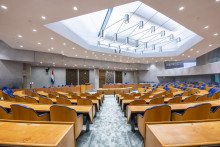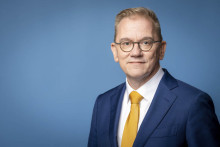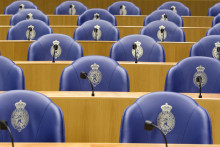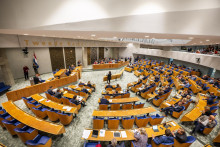Education Minister Robbert Dijkgraaf has promised to send a letter to the House next month about his plans concerning the internationalising of higher education. But the House of Representatives has been discussing the issue for many years and is now losing patience.
During a debate on the influx of international students all kinds of motions were tabled; many of them gained a majority in the House of Representatives. Dijkgraaf therefore has to implement them or refute them.
Dutch
One of them is a motion by Pieter Omtzigt about the language of instruction in higher education. Almost everyone supported that motion, including three of the four coalition parties. Dijkgraaf’s own party, D66, voted against it.
By law, study programmes must in principle be carried out in Dutch, according to the motion. Omtzigt wants the inspectorate to enforce that law and to give a better explanation of when study programmes may and may not make an exception to it.
Omtzigt was happy with the support of the House. He wants to hear from the minister within a week ‘how we will ensure that Dutch once again becomes the language of instruction in Bachelor’s degree programmes at universities, because that is the purpose of the motion’.
But that was not spelled out in so many words in the motion and it is unclear whether other parties construed it as such. A PVV motion to that effect was rejected. It asked the government to restore Dutch as the language of instruction ‘in all Bachelor’s degree programmes, with a few well-chosen exceptions’.
Figures
Roughly half the Bachelor’s degree programmes at universities are still given in Dutch, according to figures from Universities of The Netherlands (UNL). It is different for Master’s degree programmes: only 14 percent are in Dutch.
The number of international students is growing rapidly, especially at the universities. In 2016, 8,600 students came to the Netherlands for Bachelor’s degree programmes at universities: 18 percent of the total intake. Five years later there were 18,400, or 29 percent.
In the same period the number of international students in Master’s degree programmes at the universities rose from 11,400 to 17,900, or from 27 to 32 percent. The figures for the current academic year are not yet known.
In general, the rise is not as great at the universities of applied sciences. In 2021, less than ten percent of the first-year students came from abroad.
Housing
Additionally, a notable motion by the SP was adopted in the House of Representatives. It states that institutions need to take more responsibility for finding accommodation for international students they bring over here. If not, those students will fall victim to inflated prices and slum landlords – if they can find housing at all.
Another motion by the SP asks the government to look at university funding: do they recruit so many students because they get money for it? That motion also got a lot of support, from the VVD among others.
And what happens when those students have graduated? A motion by the CDA states that three quarters of the international students leave the country. Perhaps it’s because they don’t speak Dutch, the party suggests. The motion advocates better monitoring of the factors that could keep international students in the Dutch labour market.
Look ahead
It could have been even worse for Dijkgraaf if coalition parties VVD and CDA had not ‘held back’ a couple of motions. No vote was taken on those; the parties are keeping them in their back pocket. In those motions the House of Representatives would have asked the government to put forward legislation as soon as possible to control the influx of international students.
The coalition evidently did not want to tread on the minister’s toes just yet. Now there is nothing to do but wait for the plans that Dijkgraaf will unveil in March. The tension is growing; the minister risks being unable to meet the expectations, in which case the parties would take control of the matter.








